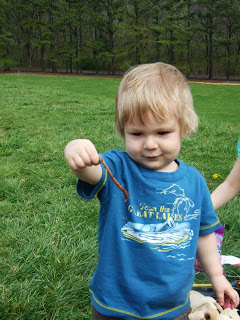This time around, Ava was excited to be fishing, so I took her to the place I mentioned a while back that I hoped would work out for them. We had a Dora rod, a little tackle box, a bobber, and some nightcrawlers -- a perfect set-up for a three and a half year old. I had to do the casting (and provide varying degrees of hooksetting help), but it didn't take long until we brought the first fish (ever!) to hand:

The kids, happily, were thrilled. I didn't know how they'd respond, but they were both fascinated. Of course, some of us were equally interested in the bait as we were in the fish, but that's fine.

The kids took a break to go to the playground (and look at the mating frogs -- without explanation -- on the way), and after looking at some turtles, I started fishing. I had seen a huge bass earlier and was optimistic. The crappies were spawning, so I didn't go after them, but was hoping there were some post-spawners about.
I quickly took a decent bluegill and bass in the little cove. I moved back to the open area and switched to a topwater plug just to see what would happened. I had a strike from a huge crappie (hooked just enough to turn him and see the size) and then took a crappie and big 'gill.
Nicole and the kids came back, so I grabbed the Dora rod and went back to kid mode (mostly). Ava soon caught a blugill and a hefty 8-inch crappie, which put up quite a fight on the little rod. Unfortunately I didn't bring the camera to this part of the outing (although if I had I could also have photographed the northern watersnake the grown-ups saw). Then we hooked and lost a few. According to Ava, these fish wanted to eat the worm without trying to come up to say hi. Jasper started to get bored, and it seemed like a good idea to stop before Ava did, too. So even though she was still fishing intently. We stopped for ice cream on the way home, which was a perfect way to end a perfect day.
